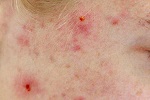
Imagine a skin condition that leaves blisters when a new mom holds her baby. And even a walk to the mailbox is excruciating from the friction to her feet. That's Grace, a New Zealand woman with epidermolytic hyperkeratosis or EH. It's the abnormal growth of a protein in the skin that makes its cells fragile.
The skin is made up of three layers with the outside being the epidermis. Under that is the dermis and then the hypodermis. Most of what makes up the epidermis, the part we touch, are called keratinocytes and we shed about five hundred million of these dead cells daily. Most of the proteins in these cells are keratins which form filaments that make the epidermis durable. They protect us against microbes, UV rays, and water loss.
EH results from mutations in either one to two genes that encode keratin proteins. The mutations change linkages between the proteins creating abnormal structures. This leads to a thickening of the epidermis making it fragile and prone to infection. For Grace, her skin produces too much keratin and any friction causes her skin to blister and peel. She has to trim extra skin, take exfoliating baths with bleach, and uses an electric scooter to get around. But genetic testing has allowed her to have two babies without the condition.
She's also found ways to live a full life with the illness. Part of that is thanks to her husband and much of it to her own resilience because there is no cure for her disease.
More Information
Florence Epidermolytic hyperkeratosis
Epidermolytic hyperkeratosis is a skin disorder that is present at birth. Affected babies may have very red skin (erythroderma) and severe blisters. Because newborns with this disorder are missing the protection provided by normal skin, they are at risk of becoming dehydrated and developing infections in the skin or throughout the body (sepsis)....
Life with too much skin: Grace Wallace lives with a rare condition, and conceived through IVF to avoid passing it on
Bathing in Janola twice a day is a ritual for Grace Wallace, to help with her rare skin condition. Epidermolytic hyperkeratosis - which makes the 29-year-old's skin grow much faster than usual - is also the reason she and her husband conceived through IVF, with genetic testing...